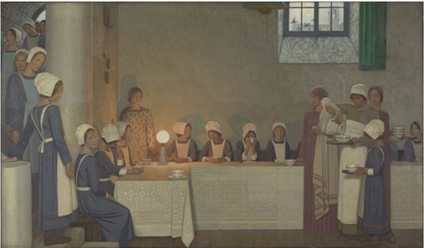Frederick Cayley Robinson at the National Gallery.
In 1915 a now little known English painter named Frederick Cayley Robinson painted four ambitious and monumental canvases for the entrance hall of Middlesex Hospital. Commissioned by one of the hospital’s governors, an Australian-born mining tycoon and philanthropist named Edmund Davis, it was hoped that these works might raise the morale of staff and patients during the First World War.
Cayley Robinson’s paintings remained on display at the Middlesex for more than 80 years. But then in 2007 their future seemed to have been placed in jeopardy by the closure of the hospital. After a brief spell on loan to Tate Britain they were acquired last year by another of London’s medical institutions, the Wellcome Library, where they are to hang from later this year. Before they gop to their new home they can be seen at the National Gallery, the centrepiece of a small but fascinating display in the Sunley Room. The collective title of the four paintings is Acts of Mercy, a subject traditionally associated with the institutions of Christian charity such as hospitals, almshouses and refuges for the poor and the plague-ridden. There were traditionally seven Acts of Mercy, which included the burial of the dead as well as six other forms of charity, such as feeding the hungry and craing for the sick, enumerated by Jesus himself in a parable in the Gospel of Matthew. These subjects were depicted in hospitals and churches from the early Renaissance onwards. The most celebrated depiction of the Seven Acts was painted by Caravaggio, who compressed all the works of Christian charity to a single convulsive scene taking place in the flame-lit gloom of a Neapolitan street at night.
In creating his own Acts of Mercy for the Middlesex Hospital, Cayley Robinson looked...


